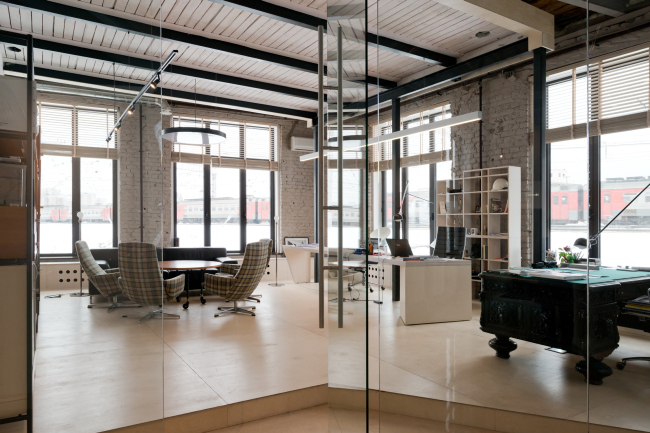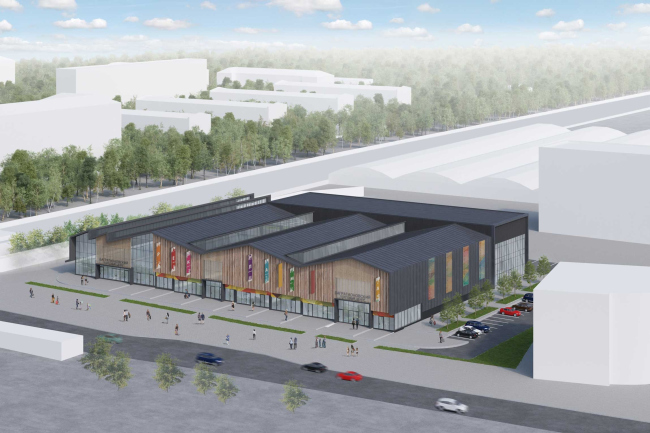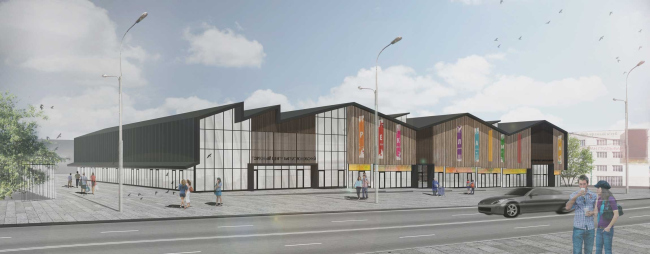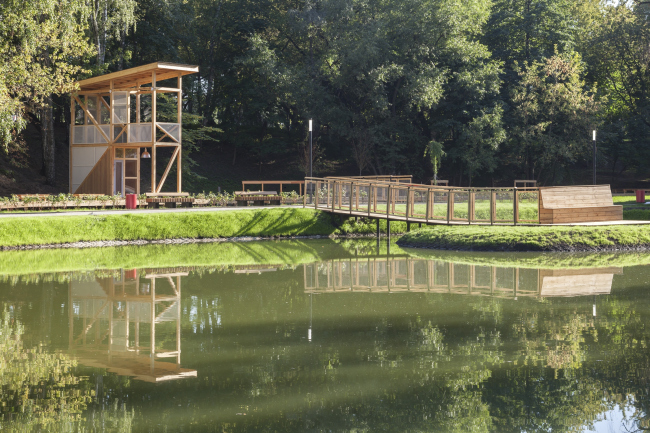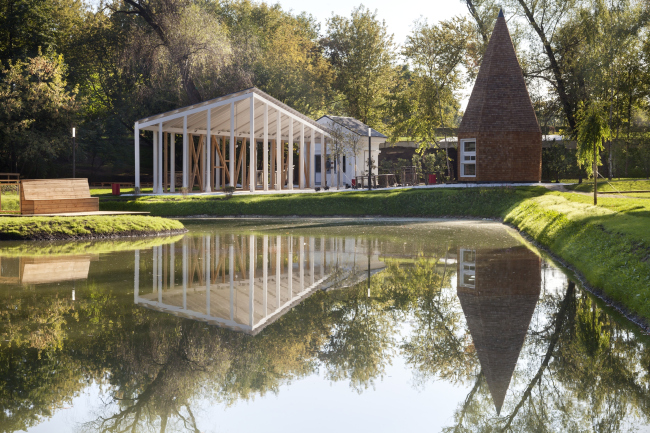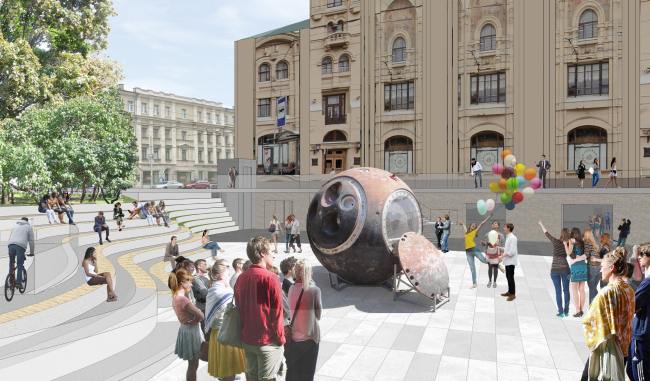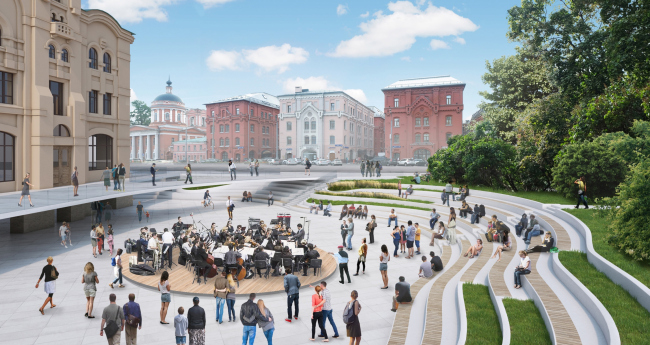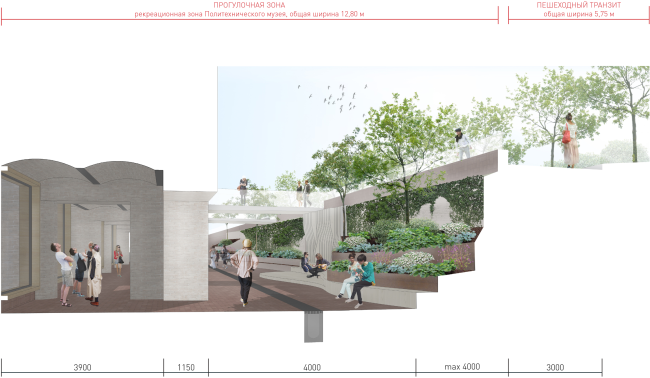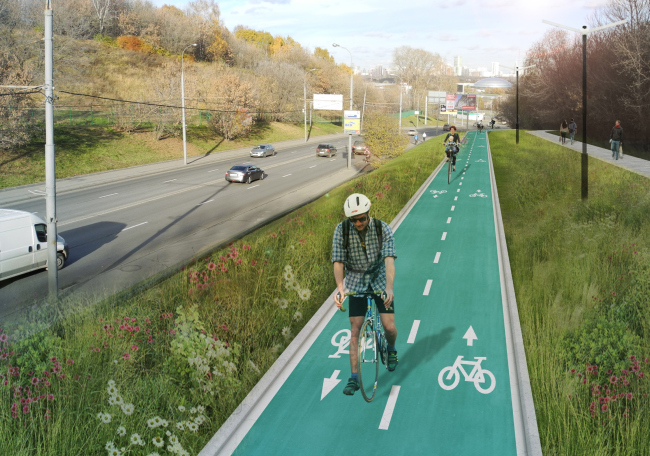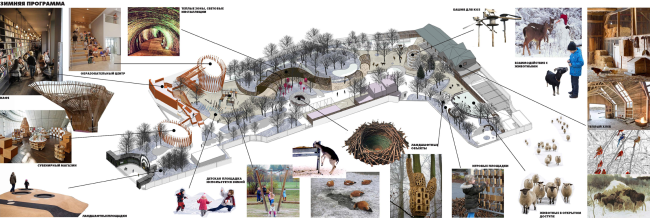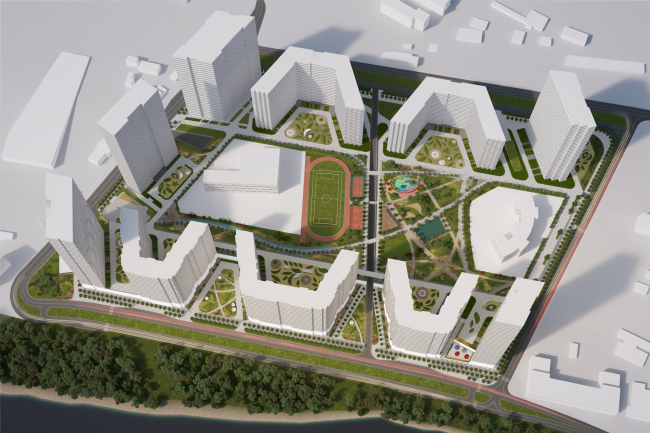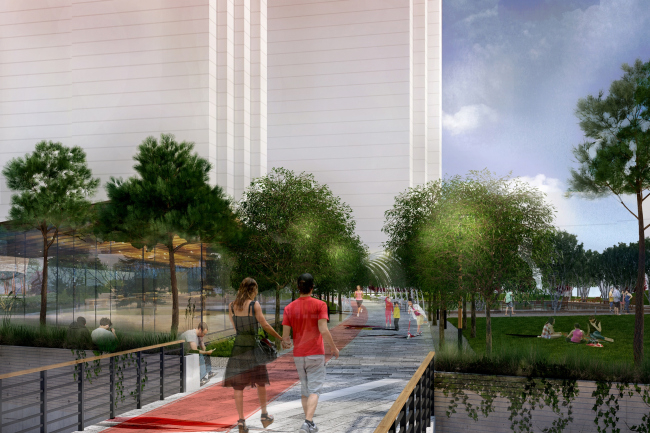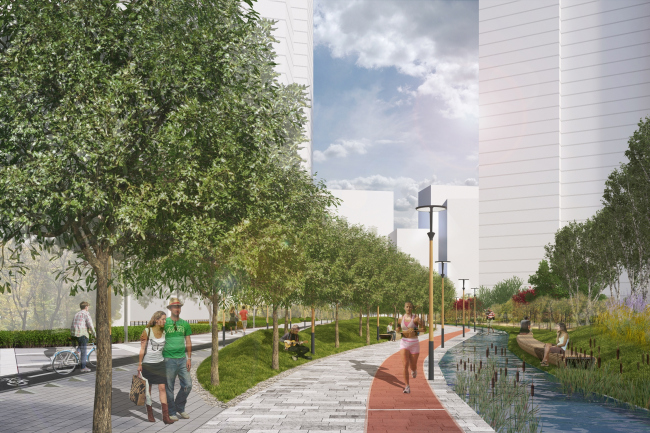|
Published on Archi.ru (https://archi.ru) |
|
| 25.04.2016 | |
|
Anna Ishchenko: "We must offer our customers the projects that answer the requirements of today". |
|
|
Julia Tarabarina |
|
| Studio: | |
| WOWHAUS | |
|
An interview with the director of Wowhaus - about the specifics of her work in the architectural company, about new market trends, and about how one must react to them, as well as about new projects and internship. Anna Ishchenko. Photograph © Âèòàëèé ÊèðþòèíWowhaus Bureau that seemingly was founded not so long - nine years ago - quickly gained popularity thanks to its smartly designed and smartly implemented projects of public buildings and territories, such as Strelka Institute, the Krymskaya (Crimean) Embankment, and the Urban Farm at VDNKH. Wowhaus seems to be the child of "Sergey Kapkov's Moscow", "The-Village" hero, a team that changes the city to fit the hipsters' needs, and a living model to follow for many young architectural companies. The company wins the contests for the best projects of developing public parks, for example, the park of Sokolniki, and it lands the contracts for designing bicycle routes. Meanwhile, the Wowhaus portfolio also includes the carefully thought-out, beautiful, and, as the authors themselves confess, expensive project of restoring and renovating the Stanislavsky Theater and turning it into what we now know as "Electrotheater". Anna Ishchenko has been the director of Wowhaus bureau since the day of its inception; before she took up the job, she worked as the editor-in-chief of "Bolshoi Gorod" ("Big City") Magazine. We met with Anna to speak about her career and the company's plans for the future, about business priorities, about the history behind some of the company's projects, as well as about where the specialty of the architect ends and at which point other experts come into play. Archi.ru: - Wowhaus is known, first of all, for the names of your visionaries – Dmitry Likin and Oleg Shapiro. And the job of the director of such company - just what is it exactly about? Anna Ishchenko: - Well, as a matter of fact, the director does everything except for the actual design. Back in 2007, when Dmitry and Oleg decided to start an architectural firm of their own, they called on me to help them organize things. And this is exactly what I've been doing ever since then, even though the scale of these things is, of course, a little bit different today. Now I don't run things here all on my own - I have a team of people to help me out. Our company is developing, and we are exploring new markets. But, more importantly, we organize our work in strict accordance with the fundamentals of the smart customer service. The way I see it, architecture as a profession fits this definition rather well, although with some reservations: it's not only about business - it's about a unique author product. In Russia, traditionally, this "author" is the operative word: I am the author, I am the visionary, I am the one who creates things. And we don't have any problems with that - it's just that we also want it to function as a business. And this is what my job is all about! - And how exactly do you move your business forward and explore the new markets that you've mentioned? - This all is about working with new customers. Actually, this is the genre classic, and it is very common in any kind of creative customer business, for example, in advertising, where I and our chief development officer, Olga Mashinina, used to work before we came here. But in architecture, and particularly in Russian architecture, it's not a common thing yet. During the lucrative years, nobody even thought about it: you occupied a certain niche, and you got yourself a certain circle of customers that you worked with. However, after we all found ourselves in this situation of global uncertainty, it became pretty clear that you can't just sit around waiting for the customers to show up if you want to survive and if you have to put food on the table. This is why we decided to take a more proactive attitude and start developing in new directions, establish new business ties, and look for new markets and customers. The interior of the Wowhaus office, 2016. The leaders' office. Photograph © Ilia Ivanov- You are very intriguing. What do you specifically do to find these new markets? - First of all, we try to understand which unexplored niches there are, what we can offer in these areas, who can be interested in our ideas and benefit from working with us. There is also a reverse process when people themselves turn to us to solve various tasks. Sometimes, upon careful examination of the problem, the customer's initial request can be vastly different from what we ultimately design for them. And it's of huge importance to be able to establish the right kind of communication with the customer and understand just how we could be useful to each other. This initial stage is a "negotiation" one, and it traditionally the chief architect's job to do it. In our company, however, our chief architects want to concentrate more on the designing work as such. This is why they partially delegated this interesting task to us. - So, you are the person that, first of all, talks to the customer? - Naturally, this is something that our partners and our chief architects do as well because nobody but the architect himself can better share his vision of the future project. But there are loads of things that you also need to discuss with your customer - you need to get a perfect understanding of what he is actually after, and whether or not he is aware of the actual magnitude of his task - which is not at all always the case. There are other organizational and commercial issues and conversation subjects. And it's me who is in charge of all these things; I also get help from the development department headed by Olga Mashinina. Oleg Shapiro and Dmitry Likin only show up to talk about the actual project. There is yet another narrative – one about the strategic planning: who or what we are, where we are going to, and where we ultimately want to go. When we think about ourselves as a firm, we get together with Oleg Shapiro and Dmitry Likin, voice our opinions, maybe do a brainstorm session, and then I try to structure all this stuff and hopefully channel it in some direction. - So, how specifically do you change your direction and where are you planning to go next? - Today, both the economic situation in general, and the business of our customers are constantly changing; currently, we are only observing the first stage of this process. The development business definitely cannot operate anymore the way it did for the last fifteen or twenty years. Accordingly, the architect's tasks will also change. We must think two steps ahead of the changes and we must be able to come up with the next big thing! Try to imagine a very simple situation: people bought a land site figuring that they would build, let's say, a business center on it, or maybe divide it into smaller segments and build townhouses on it. As a rule, all this land was bought a long time ago when people knew exactly what they would do with it. And now it turns out that what they'd planned to do is now economically ineffective and plain detrimental. And we, using the expertise we accumulated over the years, as well as the expertise of our colleagues who are into sociology, economics, and marketing, go beyond the mere task of designing something that we were asked to design - we also try to figure out just what to build in this or that place, and how successfully it would ultimately work. - So, you function as a marketing agency as well, don't you? - Of course, we work in cooperation with the customer's marketing department because the final decision is still up to the customer anyway. It's up to them how much to spend. What we do, on the other hand, we call a development concept or social/cultural programming: this is something that's not only about form but about content as well. I will give you an example - it might be slightly irrelevant but it’s very vivid. We have a project that quite recently received the architectural and urban planning approval - this is a market situated next to the Bagrationovskaya metro station. This is a regular flee market where they sell potatoes, cucumbers, and even giant-size bras... Originally, it was planned to build a 40-thousand square meter business center on that spot. Way back, our customer purchased that strip of land, and he had the so-called "city development plan for land" for that place, in accordance with which a usual Class-B business center was to appear on that spot. However, upon getting their hands on all the required documents, they sat down to calculate how much the construction would cost them, including the land tax, and it was really quite a lot. Add to it the fact that today there is no demand for this type of property whatsoever, and add to it the fact that they still were supposed to liquidate the old market that was originally there or they would lose that land. And then the customer had an idea: old as it is, the market is already there, it is functional, they manage it themselves, this place is already popular with the locals - we have a good thing going, let's make another market, only a better one. A great idea! And right now we are designing it. Well, in this particular case it was the customer that came up with this brilliant idea but sometimes it's us who prompts ideas of such kind to our customers. "Bagrationovsky" flea market, reconstruction project © Wowhaus, 2016"Bagrationovsky" flea market, reconstruction project © Wowhaus, 2016- And can you give an example of you yourselves coming up with some brilliant idea? - The urban farm at the VDNKH, for example. We came up with it. Well, we wouldn't go as far as to claim to be the pioneers of the idea that it would be nice for the city to have such a farm for kids to come to; it is a common world practice but most of the time such farms are very small, the size of a yard, really, people organize them themselves. Our girls specially went to Germany in order to study their experience. Our farm is about ten times as big. - How did it all begin? The VDNKH management came to you with this land plot? - The management of the VDNKH came to us with question: could you guys please come up with something somewhere? It's understood that we cannot do any radical changes to the infrastructure of the VDNKH for obvious reasons: first of all, this is an architectural monument, and, second of all, this place does have a memory. But, luckily, it also has agricultural pavilions in it, and it was clear that there was no point exhibiting in them what used to be exhibited during the soviet times - some kind of cow with a wonder udder or some world's biggest pig - nobody would pay to see such stuff. Rescuers' tower. Urban farm at VDNKh, 1st phase. WOWhaus Bureau. Photograph © Dmitry ChebanenkoThe view of the cafe. Awning and pencil-kiosk. Urban farm at VDNKh, 1st phase. WOWhaus Bureau. Photograph © Dmitry ChebanenkoNevertheless, we wanted to leave the agricultural narrative intact in that place - filling it with a new meaning. And we felt that an urban farm would best fit in there. There were plenty of reasons for that: the city kids probably don't have a clue as to where their food comes from, they miss out on the tactile sensations, only pushing buttons and touching touch-screens... Then we calculated the economic side of the project. We analyzed how many people would come to that place, from where these people would come, how much they would be ready to pay for the entrance ticket, which services would be rendered free of charge, which would cost money, and, generally, which services would be in demand there. As a result, we came up with a manual that we called "Functional Service Model". Based on that manual, it was the VDNKH that looked for the operator. And, initially, they had quite a hard time finding one because when they approached this or that company with this idea of an urban farm they would usually hear something like: "Sounds like total nonsense, this is not even a business, and we will only be losing money through it!" - And to what extent the expectations of your business plan match the realities of the functioning of the first phase? - I know for sure that the VDNKH is happy with the outcome. During the weekends, the kids stand in lines to see it, there is a great number of scheduled school tours. Everyone is happy. We did the right thing. - Wowhaus has a reputation for being a firm that specializes in venues and parks. Does this mean that now this specialty will slowly recede into the background? - Not at all! It is just a coincidence that at a certain point we did a significant number of projects in this field. First of all, it was the Krymskaya Embankment and the project of the Revolution Square that is not implemented yet. Right now, we are collaborating with the Museum Park next to the Polytechnic Museum, adapting the Ishigami concept. We were able to propose an idea that helped to implement the main concept of the Japanese architect that won the international competition in 2011, and at the same time keep intact the little park in front of the museum from the side of the Lubyanskaya Square, as well as solve a few traffic issues. Our concept was approved by all the appropriate departments of the government of Moscow. Currently, the project is operated by Mosproject-3, and we collaborate with this company as well as the authors of the updated concept, this time fine-tuning our concept to fit the requirements of the designers, master plan developers, and budget constraints. Museum park next to the Polytechnic Museum, project © WowhausMuseum park next to the Polytechnic Museum, project © WowhausMuseum park next to the Polytechnic Museum, project © WowhausI can say for sure that this specialization is not leaving our circle of specialization. If asked to design a park or a city square we will happily do it. Furthermore, our current plans include working on public territories in two major Russian cities. I cannot share all the details yet - but these are interesting and ambitious projects, and we are happy that the philosophy of developing public territories that we maintain is finally starting to go beyond the scope of Moscow. At the same time, we actively cooperate with large developers - we design for several residential complexes the concepts of territory organization and improvement. We also did a few projects for Mosgorpark that will be implemented shortly. For the Transportation Department, we are doing a very promising and important project of the bicycle route called "Green Ring". Currently, about half of the ring has been designed, about 64 kilometers long. It predominantly runs through parks, from the park of Sokolniki over to the Moscow State University. We came up with a recreational bicycle route with a full infrastructure and all the necessary transitions - one that would, first of all, actively use the already existing bicycle trails, and, second of all, would connect the points that were hitherto separated. We hope that all this will be implemented. "Green Ring" bicycle route © Wowhaus, 2015Public venues and parks will remain our specialty but now it's just one of the things that we do. - And how often do you propose to your customer a project in such a "preliminary" way - meaning, without either contest or contract? As far as I understand, this was the case with the Revolution Square? - This was the case with the Krymskaya Embankment. The city did schedule improving the Revolution Square, we were asked to draw a sketch in order to come up with more exact specifications, then there was a tender that we won, and thus we were able to perfect those initial sketches. We love to come up with such interesting things that we hope are important for the city - but you cannot lead such an activity systematically. You cannot predict which idea will go into further work, how many resources and how many lucky coincidences it will take to go from an abstract idea to its implementation. - And, generally speaking, how is the production process organized in your company? I know that in some companies they organize "inner competitions"; other send their young talent to take part in virtually all the contests in the world... - We will be sure to organize this year a contest department within our firm because we want to take part in more of them. As far as "inside" competitions are concerned, I cannot say I am a huge fan of this idea, because we encourage not so much competition as joint cooperative work. And in this area we would rather resort to the format of the inner workshops: you set a task, and people come together to find a solution. And, speaking of such workshops, we not only organize them to work on some specific commission but for the inside brainstorm as well. Another important point to us is the search for young talent, staying in contact with the young architects. In the summertime, we organize internship for the students of architectural universities and colleges. And this year we decided to launch a full-scale three-month long internship for the young architects - right now the work of the first flow is bring completed but we will be sure to carry on with this. The idea of internship came to us a long time ago but at that point, when we had our office at Red October, we had no room for that. We did take an odd student or two for the summer practice but that was about all we could afford to do. After we moved into a new comfortable office at Artplay, we thought - well, now it's time for us to implement this idea! The internship is curated by our employee, Olya Rokal, she is a great architect, and she is also a great organizer and curator of such programs. The first serious task that we gave to our interns was the workshop dealing with the Nikola-Lenivets project that is planned to be implemented this summer. Oleg Shapiro gave the task, he proposed the idea to them, and they got down to thinking about it, under Olga's guidance. Then - and thus is the story that Oleg shared with me - I came to them a week later. I thought that they would come up with eight different versions, each student bringing one of his own, without sharing his stuff with the others. However, I was amazed at what I saw: they were able, all the eight people, to develop one and the same idea in eight different aspects. What ended up happening, they all worked together as a team on one project: one made a visualization, another made another visualization, a third came up with a construction, a fourth contributed something else, and so on. We were very happy with the result. As the outcome of this internship, we are planning to offer some of these boys and girls work in our company. - Do you pay your interns? - We do. Just a little - but we do. - And you pay your students at the summer practice as well? - No, unfortunately, we do not have the opportunity to pay them for the summer practice. The interns, they all have a bachelor degree, and they are capable of more than those third-year students, although some of the students are also very talented. Once a young student came to the summer practice, and he landed a job with our company after that. This, however, is rather an exception than a rule. We do pay the interns, however, because they are almost grownups, and we invest in them because after the internship some of them will indeed stay with our company. And as for the students - yes, there are bright guys among them but often they are really high-maintenance. - Who are your customers, mostly? - Right now, our major customer is the Polytheistic Museum, or, rather, Mosproject-2 that is their master designer. It is that company that corrects the working documents. The Polytechnic Museum has quite a history behind it. And what we do is implement a concept of a state-of-the-art, technology-based, world-class museum. Wowhaus contributes to working on the exposition, planning and subject-matter zoning of the expo spaces; develops the project of multifunctional spaces in the museum's covered inner yards, and restoring and adapting the Major Auditorium, on the basis of which we create a highly contemporary concert and theater complex. The trend of this year is the appearance of major commissions from the regions: these are privately owned companies that are interested in taking their home cities to a new level and ready to invest in it - which gives us hope that things are rather on the upside after all. I cannot share more details with you yet but literally in a month or two we hope we will be able to share some pretty exciting news. In addition, the list of our customers includes a few large developers, such as MP-Group, Donstroy-Invest in Moscow, Forum Group in Ekaterinburg, and others for whom we develop landscaping and land improvement projects. We are also finishing the project of a children's zoo: it takes up a portion of the Moscow Zoo that opens up to the Garden Ring. - Is it going to be something like your urban farm? - Well, yes and no. Something like in the sense that, yes, it will have domestic animals in it, and, yes, this is a kids narrative about domesticating animals: how the whole process took place and so on. In the zoo, we cannot organize things the way they are on the farm, the zoo has a huge flow of people going through it, and there are rules to be obeyed: from a formal standpoint, a zoo is a museum, it has an exposition and it has a stock, and we had to study all these things and understand them. Project of reorganizing the Minor Territory of the Moscow Zoo © Wowhaus, 2015-2016Copyright: © WOWHAUSProject of reorganizing the Minor Territory of the Moscow Zoo © Wowhaus, 2015-2016Copyright: © WOWHAUS- And you also wrote a program for that zoo? - Yes, we wrote the program together with the zoo's zoologist and some invited biologists, popularizer of science, pedagogues, and sociologists. We though out not only the organization of the flows but also the educational programs for kids and other content points. Quite a lot of things, I should say. - Why did you decide to go in for programming as well? - This tendency came up a long time ago. Oftentimes, a customer comes to us and he sets the task in a very broad way, much broader than the architects can adequately respond to, as a rule. At first, we would try and resist such customers but then we thought, hey, why do we have to say "no" just because we cannot do something? Maybe it's about time we learned how to do it? - Do you offer to your clients to do this conceptual work for extra money? Or individually, without even developing a project? - Separately from architecture - no! All that's connected with the research part, sociology, economy - we don't do these things ourselves; we have outsource partners, and we commission them to do the job. Furthermore, for some of our customers, they work on a separate contract. For example, we reach an agreement that the marketing of the project is something that the customer does individually, and then he brings it to us in the form of technical specifications. But then again, more often we wrap it up for the customer as a single product. But separately, without architecture, we sure will not don it. We're not interested in becoming resellers. - Which experts do you invite, for example, to improve the territory around a residential complex? - Those that I've already mentioned, actually. We had a model story with Donstroy's residential complex "Serdtse Stolitsy" ("Heart of the Capital"). In fact, this is a whole residential block buildings standing along its perimeter, with a 14-hectare yard inside, a school and a kindergarten - a very large block with a very large yard. On the bottom floors, there are public and commercial functions - their location came to us in the form of "givens". Here what mattered to us was the sociological modeling data because without them we would not have understood just what locations would enjoy popularity and what would not. We, of course, could have thrown together something based on plain common sense - but that would have been the wrong approach. Land improvement of "Serdtse Stolitsy" residential complex © Wowhaus, 2015-2016Land improvement of "Serdtse Stolitsy" residential complex © Wowhaus, 2015-2016Land improvement of "Serdtse Stolitsy" residential complex © Wowhaus, 2015-2016For example, our colleagues did a research as to where which transport already functioned, and which was only in the planning stage; what institutions were already there, how people go to work past these houses, and predicted the human flows. And it turned out that no person ever would reach the location where it was initially planned to build the supermarket. The customer listened to us, and designated a different location for that supermarket. Similarly, we thought out the landscaping part: together with the sociologists, we designed the scenarios for the little ones, for the teens, and so on - by the hours of the day, in order to watch which group hangs out where so that they would not get in one another's way. What's the main issue in such cases as a rule? The teens have no place to hang out, so they end up hanging out on a children's playground where they have no business being; besides, there are these old babushkas sitting on the benches next to the hallways who are also far from being delighted by this vicinity. We tried to set these things apart as much as we could. But we were doing this, based on the model that the sociologists gave to us. - The stories that you've been sharing are rather pragmatic. Do you ever try to propose any cultural functions - museums, libraries, exhibition halls? How great is the demand for it, and does it ever work out? - We try to get our customer interested. At our first meeting with the customer, we share about the entire range of the possible public functions, and watch for the customer's reaction. Regretfully, any public function only lives so long as there is someone who takes care of it. A library cannot exists without books and without a librarian. And this means that extra resources will be needed. If we see that the customer is willing to go for something of the kind, we start discussing it with them, and we try to implement our ideas. If we realize that there is a zero reaction, however, we will not try to trust our opinion upon them. This is rather often what ends up happening because the developers are only beginning to realize that what matters is not just the square meter and the price that you pay for it but also what you see on your way from your car or from the metro station to your apartment, and where your child can go for a walk with a nanny or a granny. |
|

